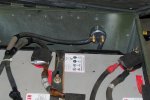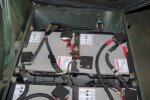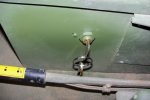American Patriot 1960
Member
- 78
- 41
- 18
This should help in determining the proper wider gauge to use for pretty much any application you might have, (Just click the link):
Wiring Size Guide
Also, further info - General wiring rules of thumb:
*When modifying a factory circuit, you never want to use smaller size wire.
*The higher the amperage to be carried, the larger the wire needs to be, (Fairly obvious to most people)
*The longer the wire, the larger it needs to be, (Not nearly as obvious to most people but every bit as important!)
*Ground wires should be the same size as the positive wires unless they are considerably shorter.
*Every connection in a circuit causes either voltage or amperage loss (OR BOTH) Limit the number of connections/splices as much as possible.
*For optimal function, you should never run power wires in close proximity parallel (Along side of) wires used for things such as antenna, speakers if you can avoid it. If you must do so keep the length of the parallel runs as short as possible.
*Keep audio, antenna and data cables as far from engine ignition system components as possible.
*In vehicle electrical systems the negative (Ground) is just as important as the power. Provide a poor ground and you will get poor results. A good solid CLEAN ground will provide for brighter lights, longer life of any electric motor (Like your starter)
*All circuits should be fused for safety and that fuse should be located as close to the original power source as possible.
*Never replace a fuse with one of a higher rating, (Should go without saying, but I see it all the time).
*Most switches are not rated for more than a few amps, usually in the range of 5amps or less. When installing "Stuff" be sure you know the load your putting on the switch and use a good quality relay if you are even close (75%) to the rating of the switch.
*It should go without saying but you always want to protect your wiring from any moving parts. From vibration, excessive heat. You can get split loom from most auto supply houses and NAPA sells it in several sizes in 50 and 100' rolls. For a professional looking job, I always use spit loom on 100% of the wire run, from terminal to termination, just like the factory does. It looks good and protects the wiring.
*Use a good quality crimping tool to insure the best quality termination for your wiring jobs. Like this one, (Available at most auto parts houses only costs about $20.00) Ratcheting terminal crimper It works MUCH better than and gives much better quality terminations than the $5.00 tools that look like this one: "Heavy duty crimper"
*Use QUALITY crimp terminals. There is a big difference between a quality terminal and the cheap ones most auto outlets sell. The NAPA Belden brand ones are a good place to start. You can also get ones that have a solder ring built in and heat shrink tube. You crimp them then hit with a heat gun. That melts the solder and shrinks the tubing for a very professional almost weather proof termination. For a true weatherproof termination crimp terminals with a silicone like materiel, that melts when you hit them with a heat gun then solidifies when cool is available, (These also have the heat shrink tubing).
Hope this helps.
Wiring Size Guide
Also, further info - General wiring rules of thumb:
*When modifying a factory circuit, you never want to use smaller size wire.
*The higher the amperage to be carried, the larger the wire needs to be, (Fairly obvious to most people)
*The longer the wire, the larger it needs to be, (Not nearly as obvious to most people but every bit as important!)
*Ground wires should be the same size as the positive wires unless they are considerably shorter.
*Every connection in a circuit causes either voltage or amperage loss (OR BOTH) Limit the number of connections/splices as much as possible.
*For optimal function, you should never run power wires in close proximity parallel (Along side of) wires used for things such as antenna, speakers if you can avoid it. If you must do so keep the length of the parallel runs as short as possible.
*Keep audio, antenna and data cables as far from engine ignition system components as possible.
*In vehicle electrical systems the negative (Ground) is just as important as the power. Provide a poor ground and you will get poor results. A good solid CLEAN ground will provide for brighter lights, longer life of any electric motor (Like your starter)
*All circuits should be fused for safety and that fuse should be located as close to the original power source as possible.
*Never replace a fuse with one of a higher rating, (Should go without saying, but I see it all the time).
*Most switches are not rated for more than a few amps, usually in the range of 5amps or less. When installing "Stuff" be sure you know the load your putting on the switch and use a good quality relay if you are even close (75%) to the rating of the switch.
*It should go without saying but you always want to protect your wiring from any moving parts. From vibration, excessive heat. You can get split loom from most auto supply houses and NAPA sells it in several sizes in 50 and 100' rolls. For a professional looking job, I always use spit loom on 100% of the wire run, from terminal to termination, just like the factory does. It looks good and protects the wiring.
*Use a good quality crimping tool to insure the best quality termination for your wiring jobs. Like this one, (Available at most auto parts houses only costs about $20.00) Ratcheting terminal crimper It works MUCH better than and gives much better quality terminations than the $5.00 tools that look like this one: "Heavy duty crimper"
*Use QUALITY crimp terminals. There is a big difference between a quality terminal and the cheap ones most auto outlets sell. The NAPA Belden brand ones are a good place to start. You can also get ones that have a solder ring built in and heat shrink tube. You crimp them then hit with a heat gun. That melts the solder and shrinks the tubing for a very professional almost weather proof termination. For a true weatherproof termination crimp terminals with a silicone like materiel, that melts when you hit them with a heat gun then solidifies when cool is available, (These also have the heat shrink tubing).
Hope this helps.
Last edited:





